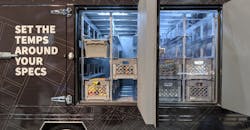Utilimaster takes aim at last-mile EV and grocery delivery
INDIANAPOLIS. Grocery delivery is expected to be a $100 billion market by 2025 and the desire -- and competition -- for electrified last-mile delivery vehicles continues to grow. Spartan Motors’ Utilimaster brand unveiled three new vehicle platforms aimed at these sectors at the Work Truck Show on Wednesday, March 6, at the Indiana Convention Center.
The fleet vehicles include two fully electric vehicle (EV) platforms alongside a truck body specifically developed for last mile grocery delivery.
The two electrified chassis include a walk-in van in collaboration with Motiv Power Systems. The chassis is powered by lithium-ion batteries and includes technologies such as: collision mitigation system, 360-degree cameras displayed on a 9” HD in-dash monitor, and DOT sensors, amongst other innovative features.
“By introducing these new vehicles and corresponding technologies, our goal is to advance the future of electric vehicles for the last mile delivery segment; and in doing so, create a better experience for our customers, operators, and consumers,” said Daryl Adams, Spartan Motors’ president and CEO.
Spartan Fleet Vehicles and Services is a business unit of Spartan Motors, Inc., which goes to market under the Utilimaster, Spartan Upfit Services, and Strobes-R-Us go-to-market brands,
The Utilimaster walk-in van powered by Motiv’s EV chassis offers the same performance as a traditional fuel equivalent vehicle, according to the company, which says users will see an 85% reduction in operating costs and 66% reduction in maintenance costs, over the life of the vehicle.
The second electrified chassis is a first for Spartan Motors and Cummins, which collaborated to create an electrified last mile delivery vehicle, specifically designed for the parcel delivery market. Built on Isuzu’s strip chassis -- the same chassis used by Utilimaster’s Reach vehicle -- its powertrain features a battery system giving drivers an 85-mile range, a 3,200 lb. payload, and less than six-hour charge time. This zero-emission EV platform represents a market-changing innovation for parcel and non-parcel delivery fleets in a GVWR Class-3 platform. Currently, the Reach vehicle is being used on parcel delivery routes across North America, according to Spartan.
Adams said that Spartan has partners who can help customers with the charging infrastructure, training and deployment. “We understand the vehicle is one part of that whole system,” he said. “Some of the customers we’ve talked to are looking for us to help them with that training, deployment and charging stations.”
He added that Spartan can work with customers who already have a charging system. The company is focusing on businesses in California, where there are vouchers for companies investing in EV. It is also looking at fleet customers in cities such as New York and Chicago.
“What were seeing is a trend of a lot of people looking to get into EV without having to rely on the vouchers,” Adams said. “They’ll take the return on investment along with the benefits of electrification.”
Grocery delivery
Spartan also showed off its new last-mile grocery delivery vehicle, which features a temperature-controlled truck body with fully customizable and configurable cargo area with climate-controlled zones, for refrigerated, frozen, and ambient temperature goods.
“The grocery delivery market is going to be $100 billion by 2025 so we want to be out in front of that,” Adams said. “They key is, you can reconfigure this how you want to. So if you want it to be all-frozen, we can make it all-frozen.”
Eric Fisher, Spartan’s director of engineering and head of R&D, said the feedback on the freezer, in particular, has been very positive. “During testing on this vehicle, it was able to maintain negative-25 degrees overnight, which is very impressive,” he said, crediting the insulation and the strength of the freezing system. “We see a lot of promise with this body design.”
About the Author
Josh Fisher
Editor-in-Chief
Editor-in-Chief Josh Fisher has been with FleetOwner since 2017. He covers everything from modern fleet management to operational efficiency, artificial intelligence, autonomous trucking, alternative fuels and powertrains, regulations, and emerging transportation technology. Based in Maryland, he writes the Lane Shift Ahead column about the changing North American transportation landscape.


